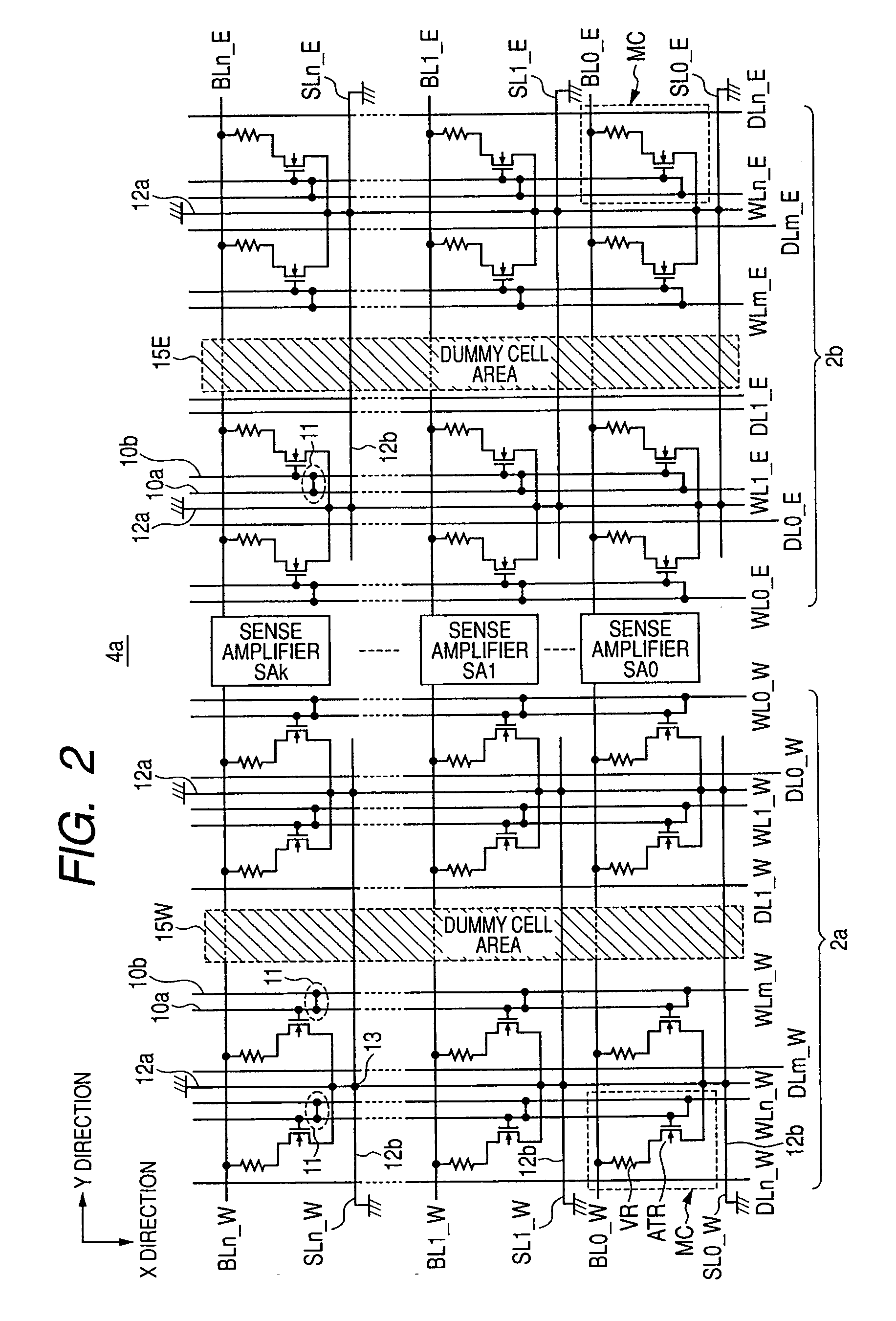Magnetic memory device
a memory device and magnetic technology, applied in the field of magnetic memory devices, can solve the problems of inability to reduce the layout area of memory cell arrays, the resistance of each source line is reduced, and the area of each mram cell is also increased, so as to reduce the resistance of each source line, the effect of efficiently disposing the piling region of word lines and reducing the resistan
- Summary
- Abstract
- Description
- Claims
- Application Information
AI Technical Summary
Benefits of technology
Problems solved by technology
Method used
Image
Examples
first embodiment
[0059]FIG. 1 is a diagram schematically showing an overall configuration of a non-volatile semiconductor memory device (MRAM) according to a first embodiment of the present invention. In FIG. 1, the non-volatile semiconductor memory device (hereinafter called “MRAM”) 1 is formed over a semiconductor chip (substrate) and includes a plurality of memory subarrays 2a through 2h. The memory subarrays 2a through 2h are arranged in line in a Y direction, and the memory subarrays 2e through 2h are arranged in line along the Y direction. In these memory subarrays 2a through 2h, MRAM cells are arranged in matrix form.
[0060]Column selection drive circuits 3aa, 3ab through 3ha and 3hb are provided on both sides extending along the Y direction, of the memory subarrays 2a through 2h respectively. Each of the column selection drive circuits 3aa, 3ab through 3ha and 3hb includes a column decoder which generates a column selection signal for selecting a column in accordance with an address signal, a...
second embodiment
[0176]FIG. 25 is a diagram schematically showing a fragmentary configuration of an MRAM according to a second embodiment of the present invention. A mode of coupling of MRAM cells to a sense amplifier where at memory subarrays 2a and 2b, memory cells of the memory subarray 2a are selected is schematically shown in FIG. 25. At the memory subarray 2a, memory cells MCa and MCb are coupled to a bit line BLaW. These memory cells MCa and MCb are different in position within the memory subarray 2a. Gates of corresponding access transistors ATR are coupled to their corresponding word lines WLaW and WLbW.
[0177]The bit line BLaW is coupled to its corresponding sense amplifier SA0 upon data reading. At the memory cell MCa, a variable magnetoresistive element VR and an access transistor ATR are interconnected with each other by means of an internal wiring LNa (intermediate wiring 40: any of 40a through 40d). At the memory cell MCb, a variable magnetoresistive element VR and an access transistor...
third embodiment
[0195]FIG. 28 is a diagram schematically showing a distribution of an initial resistance value of each variable magnetoresistive element at one memory subarray 2. In FIG. 28, the initial resistance value Rm of the variable magnetoresistive element easily increases from the center 0 of the memory subarray 2 to its ends (Lx and −Lx) in the X direction and becomes the highest at its peripheral portion. Similarly, as the distance from the center increases from the center (0) of the memory subarray 2 to its ends +Ly and −Ly in the Y direction, the initial resistance value Rm increases.
[0196]At each MRAM cell, a variable magnetoresistive element is formed by a ferromagnetic body and a barrier layer lying therebetween. The resistance value of the variable magnetoresistive element exponentially increases in accordance with the film thickness of the barrier layer. It is thus necessary to couple the barrier layer as thinly as possible. There is a need to accurately determine the composition a...
PUM
 Login to View More
Login to View More Abstract
Description
Claims
Application Information
 Login to View More
Login to View More - R&D
- Intellectual Property
- Life Sciences
- Materials
- Tech Scout
- Unparalleled Data Quality
- Higher Quality Content
- 60% Fewer Hallucinations
Browse by: Latest US Patents, China's latest patents, Technical Efficacy Thesaurus, Application Domain, Technology Topic, Popular Technical Reports.
© 2025 PatSnap. All rights reserved.Legal|Privacy policy|Modern Slavery Act Transparency Statement|Sitemap|About US| Contact US: help@patsnap.com



